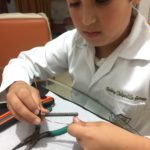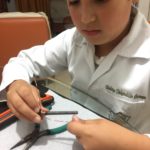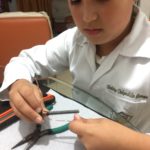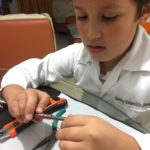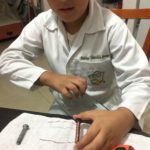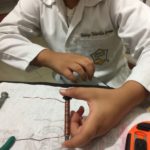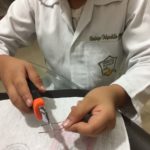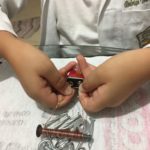Exactas y Naturales
Construcción de un Electroimán
- Categoría: Pandilla Kids (3ro., 4to., 5to. y 6to. Año de primaria)
- Área de participación: Exactas y Naturales
- Asesor: BRENDA MAYANIN SALINAS RUIZ
- Autor: RODRIGO FERNANDO DELGADILLO CORNEJO ()
Resumen
Un electroimán es un tipo de imán en el que el campo magnético se produce mediante el flujo de una corriente eléctrica, desapareciendo en cuanto desaparece dicha corriente. La corriente fluyendo por un cable produce un campo magnético en torno a él. El tipo más simple de electroimán es un trozo de cable enrollado. Se pueden encontrar electroimanes en numerosas aplicaciones de la vida cotidiana, desde relés que permiten controlar circuitos, hasta grandes grúas para cargar chatarras. Es fácil demostrar la existencia de campos magnéticos producidos por corrientes eléctricas, formando un circuito con una pila, como en este proyecto.
Pregunta de Investigación
¿Por qué el electroimán tiene la capacidad de atraer objetos metálicos?Planteamiento del Problema
Al pasar la corriente eléctrica de la pila por un cable de cobre, se genera un campo magnético alrededor de él y que éste es muy débil y no es capaz de imantar materiales como son tornillos, tuercas o clavos.
Por lo cual se necesita concentrar el material conductor en una pequeña zona, para que su campo magnético adquiere mayor fuerza.
Antecedentes
La Electricidad
La palabra electricidad proviene del vocablo griego elektron, que significa ámbar. El ámbar es una resina fósil transparente de color amarillo, producido en tiempos muy remotos por árboles que actualmente son carbón fósil.
Los primeros fenómenos eléctricos fueron descritos por el matemático griego Tales de Mileto, quien vivió aproximadamente en el año 600 a.C. el señalaba que al frotar el ámbar con una piel de gato, podía atraer alguno cuerpos ligeros como polvo, cabellos o paja.
El físico italiano Alessandro Volta (1745-1827), también contribuyo notablemente al estudio de la electricidad. En 1775 invento el electróforo, este dispositivo generaba y almacenaba electricidad estática. En 1800 explico porque se produce electricidad cuando dos cuerpos metálicos diferentes se ponen en contacto. Aplico su descubrimiento en la elaboración de la primera pila eléctrica del mundo.
Fue Georg Ohm, físico alemán (1789-1854), quien descubrió la resistencia eléctrica de un conductor, y en 1827 estableció la Ley Fundamental de las Corrientes Eléctricas al encontrar la existencia de una relación entre la resistencia de un conductor, la diferencia de potencial y la intensidad de corriente eléctrica.
Por su parte, Michael Faraday, físico y químico inglés (1791-1867), descubrió como podía emplearse un imán para generar una corriente eléctrica en una espiral de hierro. Propuso la teoría sobre la electrización por influencia, al señalar que un conductor hueco (jaula de Faraday) forma una pantalla para las acciones eléctricas. A partir del descubrimiento de la inducción electromagnética, Faraday logro inventar el generador eléctrico.
Otros investigadores han contribuido al desarrollo de la electricidad, entre ellos figuran:
El estadounidense Joseph Henry (1797-1878), constructor del primer electroimán descubrió, de forma independiente y simultánea a Faraday, que un campo magnético variable induce una fuerza electromotriz.
En particular, Henry observó que, si un conductor se mueve perpendicularmente a un campo magnético, aparece una diferencia de potencial entre los extremos del conductor.
El interés del experimento de Henry reside en que la aparición de la fuerza electromotriz inducida puede ser explicada de forma clara por la ley de Lorentz, es decir, por las fuerzas que el campo magnético ejerce sobre las cargas del conductor.
El Electromagnetismo
La parte de la Física encargada de estudiar al conjunto de fenómenos que resultan de las acciones mutuas entre las corrientes eléctricas y el magnetismo, recibe el nombre de electromagnetismo.
Oersted fue el primero en descubrir que una corriente eléctrica produce a su alrededor un campo magnético de propiedades similares a la del campo creado por un imán. Por tanto, si un conductor eléctrico es sometido a la acción de un campo magnético, actuará sobre él una fuerza perpendicular al campo y a la corriente. Faraday descubrió las corrientes eléctricas inducidas al realizar experimentos con una bobina y un imán.
Además demostró que se producen cuando se mueve un conductor en sentido transversal a las líneas de flujo de un campo magnético, este fenómeno recibe el nombre de inducción electromagnética.
| Figura 3 – Esquema de la Brujula |
Actualmente, casi toda la energía eléctrica consumida en nuestros hogares y en la industria se obtiene gracias al fenómeno de la inducción electromagnética, pues en él se fundan las dinamos y los alternadores que transforman la energía mecánica en eléctrica.
El efecto magnético de la corriente eléctrica y la inducción electromagnética han revolucionado la ciencia y han dado origen al electromagnetismo. La aplicación de sus principios y leyes ha permitido la electrificación del mundo y con ella, el progreso y un mejor nivel de vida para la humanidad.
El electromagnetismo tuvo su origen en el invento de la pila eléctrica realizado por el italiano Alessandro Volta en 1800. Veinte años más tarde se hizo por casualidad otro importante descubrimiento: mientras el físico danés Hans Christian Oersted impartía una clase de Física a sus alumnos empujó en forma accidental una brújula que se encontraba bajo un alambre conectado a una pila, el cual conducía una corriente eléctrica; observó con asombro cómo la aguja realizaba un giro de 90° para colocarse perpendicularmente al alambre (figura 3).
Con ello se demostraba que éste, además de conducir electricidad, generaba a su alrededor una fuerza parecida a la de un imán es decir, generaba un campo magnético; así se descubrió el electromagnetismo.
Poco tiempo después, el científico francés André Marie Ampere (1775-1836), descubrió que el campo magnético podía intensificarse al enrollar el alambre conductor en forma de bobina.
Este hecho condujo a Joseph Henry, a realizar otro descubrimiento importante: se le ocurrió recubrir con un material aislante a los alambres y los enrolló alrededor de una barra de hierro en forma de U. Luego los conectó a una batería y observó que la corriente eléctrica magnetizaba al hierro y cuando la corriente dejaba de circular entonces desaparecía el campo magnético de la barra de hierro. Se había descubierto el electroimán (figura 4), pieza fundamental de los motores eléctricos.
Figura 4 – Electroimán simple
En 1821 Michael Faraday construyó el primer motor experimental. Para ello, suspendió un alambre sujeto por un soporte, de tal manera que cada extremo quedase sumergido en un depósito de mercurio con un imán en el centro (figura 5). Cuando se hace pasar corriente, cada extremo del alambre se mueve en círculos alrededor del imán. Después del motor de Faraday se construyeron varios tipos de motores eléctricos que funcionaban con baterías y eran utilizados para taladros, tornos o prensas de impresión. Sin embargo, eran muy costosos y requerían de baterías muy grandes.
Electroimán
Oersted descubrió que la corriente eléctrica produce magnetismo alrededor del alambre por el que fluye, y es este magnetismo el que hace desviarse a la aguja de la brújula.
El americano Joseph Henry descubrió posteriormente que se podía fabricar un imán muy potente haciendo pasar corriente eléctrica a través de un alambre aislado enrollado varias veces sobre un núcleo de hierro. Se puede construir un imán de este tipo, enrollando un alambre aislado unas doce o más veces alrededor de un clavo y conectando los extremos del alambre con los polos de una batería.
Mientras está pasando corriente eléctrica, el clavo se comporta como un imán y es capaz de atraer otros clavos.
| Figura 6 – Esquema de Electroimán |
Cuando se desconecta el alambre de la batería, es decir, se rompe el circuito, el hierro pierde su magnetismo (figura 6).
| Figura 5 – Motor experimental de Faraday |
Esto tiene gran aplicación práctica, porque supone el poder disponer de un imán en el momento en que lo necesitemos, con sólo conectar la corriente eléctrica. A este invento se le llama electroimán.
Últimamente se utilizan grandes electroimanes adaptados a las grúas, en sustitución de los antiguos ganchos, para agarrar las planchas de hierro.
Oersted comprendió que al enrollar un cable, los campos magnéticos producidos en cada vuelta se suman. El resultado es un campo magnético fuerte en el centro y en los dos extremos, los cuales actúan como los polos de un imán. Un cable enrollado con muchas vueltas se llama solenoide. Un solenoide actúa como un imán cuando una corriente fluye por él. Los polos norte y sur cambian con la dirección de la corriente.
El campo magnético del solenoide se puede fortalecer aumentado su número de vueltas o la corriente eléctrica que fluye por el cable. Pero el mayor fortalecimiento se logra al poner un trozo de hierro en el centro del solenoide. El campo magnético del solenoide, magnetiza del hierro. El campo magnético resultante es el campo magnético del cable más el del hierro, y puede alcanzar una fuerza de cientos miles de veces mayor que la del cable solo. Un solenoide con un material magnético en su centro se llama electroimán.
Objetivo
Realizar un electroimán que atraiga objetos metálicos.
Justificación
Existen diversos aparatos y dispositivos que emplean electroimanes con diferentes finalidades. Por esa razón me interese en este tema, ya que quería dar a conocer por medio de la experimentación, ¿Qué es un electroimán? ¿Cómo funciona? Y qué características tiene.
Hipótesis
Si se tienen cargas eléctricas en movimiento, aparece un campo magnético, que es de la misma naturaleza que los que proporcionan los imanes permanentes.
Entonces demostrare la existencia de campos magnéticos producidos por corrientes eléctricas, concentrados en un material ferromagnético para aumentar su potencia.
Método (materiales y procedimiento)
MATERIALES
– Cable de cobre esmaltado.
– Un tornillo grande u otro material ferromagnético.
– Una pila de tamaño D.
– Tijeras.
– Tornillos, tuercas u otros materiales metálicos que puedan ser atraídos por un imán.
PROCEDIMIENTO
El primer paso que tenemos que hacer es enrollar el cable de cobre esmaltado alrededor del tornillo. Es importante mencionar que quede él cable lo más concentrado posible. Una vez realizado, se tiene que dejar de 5 a 6 centímetros más de cable por cada lado y cortar el sobrante con las tijeras.
El siguiente paso es quitar el esmalte de los extremos del cable. Hay dos formas de hacerlo. La primera es raspando con las tijeras hasta quitarlo completamente. La segunda forma es simplemente quemando los extremos con un encendedor o raspando con las tijeras.
Por último paso tenemos que conectar uno de los extremos al lado positivo de la pila y el otro, al negativo, Manteniendo sujetos los extremos con la pila.
Ahora para probar el electroimán acercamos el tornillo a los clavos o tuercas que tengamos preparados y veremos cómo los atraerá al momento.
Podemos probarlo con más materiales metálicos que deseemos para ver su potencia. Si soltamos los extremos del cable con la pila, dejarán de estar imantados todos los objetos y se caerán inmediatamente.
Es importante no tener conectado el cable con la pila durante mucho tiempo, ya que aumenta de temperatura y podríamos quemarnos los dedos.
Resultados
Al pasar la corriente eléctrica de la pila por un material conductor, como es en este caso el cable de cobre, se genera un campo magnético alrededor de él.
Lo que se ha demostrado en este proyecto es la concentración del material conductor en una pequeña zona, con lo que su campo magnético adquiere mayor fuerza. Con ayuda de un material ferromagnético como es el tornillo grande, canalizamos las líneas electromagnéticas hacia un mismo punto y así fue que conseguimos un potente electroimán.
Discusión
Conclusiones
El uso del electroimán es muy ventajoso en nuestra vida pues se aplica en diversas cosas que usamos a diario. El electroimán solo funciona si hay una fuente de energía actuando sobre el alambre y el clavo. Es muy interesante este experimento pues con una simple pila podemos crear un campo magnético alrededor de un clavo rodeado con un cable de cobre, para que el campo magnético sea más potente se debe dar más vueltas al clavo pues a mayor cantidad de cable será más fuerte el campo.
Bibliografía
Bibliografía
Montiel, H. P. (s.f.). Fisica General. Publicaciones Cultural.
Prentice Hall Ciencia. (s.f.). Electricidad y Magnetismo. Prentice Hall.
Shepherd, W. (s.f.). La Electricidad, La ciencia al descubierto. Anaya.
Wikipedia. (1 de Mayo de 2017). Joseph Henry. Obtenido de https://es.wikipedia.org/wiki/Joseph_Henry
El Electroimán. (20 de Noviembre de 2007). Alan Giovanni Ortega Alvarez. Obtenido de http://alangoa.blogspot.mx/2007/11/el-electroiman.html
Construcción de un Electroimán
Summary
An electromagnet is a type of magnet in which the magnetic field is produced by the flow of an electric current, disappearing as soon as the current disappears. The current flowing through a cable produces a magnetic field around it. The simplest type of electromagnet is a piece of coiled cable. You can find electromagnets in many applications of everyday life, from relays that control circuits, to large cranes to load scrap. It is easy to demonstrate the existence of magnetic fields produced by electric currents, forming a circuit with a battery, as in this project.
Research Question
Why does the electromagnet have the ability to attract metal objects?Problem approach
When passing the electric current of the battery by a copper wire, a magnetic field is generated around it and that it is very weak and is not able to magnetize materials such as screws, nuts or nails.
Therefore it is necessary to concentrate the conductive material in a small area, so that its magnetic field acquires greater strength.
Background
Electricity
The word electricity comes from the Greek word elektron, which means amber. Amber is a transparent yellow fossil resin, produced in very remote times by trees that are currently fossil carbon.
The first electrical phenomena were described by the Greek mathematician Tales of Miletus, who lived approximately in the year 600 BC. He noted that rubbing amber with the skin of a cat could attract light bodies such as dust, hair or straw.
The Italian physicist Alessandro Volta (1745-1827), also contributed significantly to the study of electricity. In 1775, the invention of the electrophore, this device generated and stored static electricity. In 1800 I explain why electricity is produced when two different metal bodies come into contact. I apply his discovery in the development of the first electric battery in the world.
It was Georg Ohm, a German physicist (1789-1854), who discovered the electrical resistance of a conductor, and in 1827 established the Fundamental Law of Electric Currents to find the existence of a relationship between the resistance of a conductor, the difference in the potential and intensity of the electric current.
For his part, Michael Faraday, English physicist and chemist (1791-1867), discovered how a magnet could be used to generate an electric current in an iron spiral. He proposed the theory of electrification of influence by noting that a hollow conductor (Faraday cage) forms a screen for electrical actions. Since the discovery of electromagnetic induction, Faraday managed to invent the electric generator.
Other researchers have contributed to the development of electricity, which includes:
The American Joseph Henry (1797-1878), builder of the first electromagnet, discovered, independently and simultaneously to Faraday, that a variable magnetic field induces an electromotive force.
In particular, Henry observed that, if a conductor moves perpendicular to a magnetic field, a potential difference appears between the ends of the conductor.
The interest of Henry’s experiment lies in the fact that the appearance of the induced electromotive force can be clearly explained by the Lorentz law, that is, by the forces that the magnetic field exerts on the loads of the conductor.
Electromagnetism
The part of Physics responsible for studying the set of phenomena that result from the mutual actions between electric currents and magnetism, is called electromagnetism.
Oersted was the first to discover that an electric current produces around it a magnetic field with properties similar to the field created by a magnet. Therefore, if an electric conductor is subject to the action of a magnetic field, a force perpendicular to the field and the current will act on it. Faraday discovered the induced electric currents when performing experiments with a coil and a magnet.
In addition, it showed that they occur when a conductor moves transverse to the flow lines of a magnetic field, this phenomenon is called electromagnetic induction.
Figure 3 – Schematic of the compass
Currently, almost all the electrical energy consumed in our homes and industry is obtained thanks to the phenomenon of electromagnetic induction, since it is based on dynamos and alternators that transform mechanical energy into electricity.
The magnetic effect of electric current and electromagnetic induction have revolutionized science and have given rise to electromagnetism. The application of its principles and laws has allowed the electrification of the world and with it, progress and a better standard of living for humanity.
Electromagnetism had its origin in the invention of the electric battery manufactured by the Italian Alessandro Volta in 1800. Twenty years later another important discovery was made: while the Danish physicist Hans Christian Oersted gave a class of Physics to his students, he accidentally introduced a compass that was under a cable connected to a battery, which was driving an electric current; he watched with amazement as the needle made a 90 ° turn to position itself perpendicular to the wire (figure 3).
This showed that this, in addition to generating electricity, generated around it a force similar to that of a magnet, that is, it generated a magnetic field; thus electromagnetism was discovered.
A short time later, the French scientist André Marie Ampere (1775-1836) discovered that the magnetic field could be intensified by winding the conductor wire into a spiral.
This fact led Joseph Henry to make another important discovery: he had the idea of coating the wires with an insulating material and wound them around a U-shaped iron bar. He then connected them to a battery and observed that the electric current magnetized the iron and when the current stopped circulating then the magnetic field of the iron bar disappeared. The electromagnet had been discovered (figure 4), a fundamental part of electric motors.
Figure 4 – Simple electromagnet
In 1821 Michael Faraday built the first experimental engine. To do this, he suspended a wire held by a support, in such a way that each end was submerged in a deposit of mercury with a magnet in the center (figure 5). When current is passed, each end of the wire moves in circles around the magnet. After the Faraday engine several types of electric motors were built, which operated on batteries and were used for drills, lathes or printing presses. However, they were very expensive and required very large batteries.
Electromagnet
Oersted discovered that the electric current produces magnetism around the wire through which it flows, and it is this magnetism that makes it drift to the needle of the compass.
The American Joseph Henry later discovered that a very powerful magnet could be made by passing electrical current through an insulated wire wound several times over an iron core. A magnet of this type can be constructed by winding an insulated wire about twelve or more times around a nail and connecting the ends of the wire with the poles of a battery.
While the electric current is passing, the nail behaves like a magnet and is able to attract other nails.
Figure 6 – Schematic of Electromagnets
When the wire is disconnected from the battery, that is, the circuit is broken, the iron loses its magnetism (figure 6).
Figure 5 – Faraday experimental engine
This has great practical application, because it supposes the power to have a magnet in the moment in that we need it, with only to connect the electrical current. This invention is called an electromagnet.
Lately large electromagnets adapted to the cranes have been used, replacing the old hooks, to grip the iron plates.
Oersted understood that when winding a cable, the magnetic fields produced in each turn are added together. The result is a strong magnetic field in the center and at the two ends, which act like the poles of a magnet. A coiled cable with many turns is called a solenoid. A solenoid acts like a magnet when a current flows through it. The north and south poles change with the direction of the current.
The magnetic field of the solenoid can be strengthened by increasing its number of turns or the electric current flowing through the cable. But the greatest strengthening is achieved by putting a piece of iron in the center of the solenoid. The magnetic field of the solenoid magnetizes iron. The resulting magnetic field is the magnetic field of the cable plus that of the iron, and can reach a force hundreds of thousands of times greater than that of the cable alone. A solenoid with a magnetic material at its center is called an electromagnet.
Objective
Make an electromagnet that attracts metal objects.
Justification
There are various devices and devices that use electromagnets with different purposes. For that reason I am interested in this topic, since I wanted to make known through experimentation, What is an electromagnet? How does it work? And what characteristics does it have?
Hypothesis
If there are electric charges in motion, a magnetic field appears, which is of the same nature as those provided by permanent magnets.
Then I will demonstrate the existence of magnetic fields produced by electrical currents, concentrated in a ferromagnetic material to increase its power.
Method (materials and procedure)
MATERIALS
– Enameled copper cable.
– A large screw or other ferromagnetic material.
– A stack of size D.
– Scissors.
– Screws, nuts or other metallic materials that can be attracted by a magnet.
PROCESS
The first step we have to do is wind the enameled copper wire around the screw. It is important to mention that the cable is as concentrated as possible. Once done, you have to leave 5 to 6 more inches of cable on each side and cut the excess with the scissors.
The next step is to remove the enamel from the ends of the cable. There are two ways to do it. The first is scraping with the scissors until it is completely removed. The second way is simply by burning the ends with a lighter or scraping with the scissors.
Finally, we have to connect one of the ends to the positive side of the battery and the other to the negative, keeping the ends of the battery with the battery.
Now to test the electromagnet we bring the screw closer to the nails or nuts that we have prepared and we will see how it will attract them at the moment.
We can try it with more metallic materials that we want to see its power. If we release the ends of the cable with the battery, all the objects will no longer be magnetized and will fall immediately.
It is important not to have the cable connected to the battery for a long time, as it increases in temperature and we could burn our fingers.
Results
When the electric current of the battery passes through a conductive material, as in this case the copper cable, a magnetic field is generated around it.
What has been demonstrated in this project is the concentration of the conductive material in a small area, with which its magnetic field acquires greater strength. With the help of a ferromagnetic material such as the large screw, we channel the electromagnetic lines towards the same point and that is how we got a powerful electromagnet.
Discussion
Conclusions
The use of the electromagnet is very advantageous in our life because it is applied in different things that we use daily. The electromagnet only works if there is a power source acting on the wire and the nail. This experiment is very interesting because with a simple battery we can create a magnetic field around a nail surrounded with a copper wire, so that the magnetic field is more powerful, the nail must be turned more, because the more cable will be stronger field.
Bibliography
Montiel, H. P. (s.f.). Fisica General. Publicaciones Cultural.
Prentice Hall Ciencia. (s.f.). Electricidad y Magnetismo. Prentice Hall.
Shepherd, W. (s.f.). La Electricidad, La ciencia al descubierto. Anaya.
Wikipedia. (1 de Mayo de 2017). Joseph Henry. Obtenido de https://es.wikipedia.org/wiki/Joseph_Henry
El Electroimán. (20 de Noviembre de 2007). Alan Giovanni Ortega Alvarez. Obtenido de http://alangoa.blogspot.mx/2007/11/el-electroiman.html


